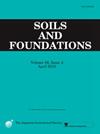A machine learning-based method for predicting the shear behaviors of rock joints
IF 3.3
2区 工程技术
Q2 ENGINEERING, GEOLOGICAL
引用次数: 0
Abstract
In this study, machine learning prediction models (MLPMs), including artificial neural network (ANN), support vector regression (SVR), K-nearest neighbors (KNN), and random forest (RF) algorithms, were developed to predict the peak shear stress values and shear stress-displacement curves of rock joints. The database used contained 693 records of peak shear stress and 162 original shear stress-displacement curves derived from direct shear tests. The results demonstrated that the MLPMs provided reliable predictions for shear stress, with the mean squared errors (MSEs) between their predicted and measured shear stress varying from 0.003 to 0.069 and the coefficients of determination (R2 values) varying from 0.964 to 0.998. The feature importance values indicate that the joint surface roughness coefficient (JRC) is the most important influential factor in determining the peak shear stress, followed by the joint wall compressive strength (JCS), basic friction angle (), and shear surface area (As). Similarly, for the shear stress-displacement curve, the JRC is the dominant factor, followed by As, , and JCS. Additional direct shear tests were conducted for model validation. The validation shows that the MLPM predictions demonstrate improved consistency with the experimental results in relation to both the peak shear stress and peak shear displacement.
基于机器学习的岩石节理剪切行为预测方法
本研究开发了机器学习预测模型(MLPM),包括人工神经网络(ANN)、支持向量回归(SVR)、K-近邻(KNN)和随机森林(RF)算法,用于预测岩石节理的剪应力峰值和剪应力-位移曲线。所使用的数据库包含 693 条剪应力峰值记录和 162 条原始剪应力-位移曲线,均来自直接剪切试验。结果表明,MLPM 可提供可靠的剪应力预测,其预测剪应力与测量剪应力之间的均方误差(MSE)从 0.003 到 0.069 不等,判定系数(R2 值)从 0.964 到 0.998 不等。特征重要性值表明,接头表面粗糙度系数(JRC)是决定峰值剪应力的最重要影响因素,其次是接头壁抗压强度(JCS)、基本摩擦角(φb)和剪切表面积(As)。同样,对于剪应力-位移曲线,JRC 是主要因素,其次是 As、φb 和 JCS。为验证模型,还进行了其他直接剪切试验。验证结果表明,在峰值剪应力和峰值剪切位移方面,MLPM 预测结果与实验结果的一致性有所提高。
本文章由计算机程序翻译,如有差异,请以英文原文为准。
求助全文
约1分钟内获得全文
求助全文
来源期刊

Soils and Foundations
工程技术-地球科学综合
CiteScore
6.40
自引率
8.10%
发文量
99
审稿时长
5 months
期刊介绍:
Soils and Foundations is one of the leading journals in the field of soil mechanics and geotechnical engineering. It is the official journal of the Japanese Geotechnical Society (JGS)., The journal publishes a variety of original research paper, technical reports, technical notes, as well as the state-of-the-art reports upon invitation by the Editor, in the fields of soil and rock mechanics, geotechnical engineering, and environmental geotechnics. Since the publication of Volume 1, No.1 issue in June 1960, Soils and Foundations will celebrate the 60th anniversary in the year of 2020.
Soils and Foundations welcomes theoretical as well as practical work associated with the aforementioned field(s). Case studies that describe the original and interdisciplinary work applicable to geotechnical engineering are particularly encouraged. Discussions to each of the published articles are also welcomed in order to provide an avenue in which opinions of peers may be fed back or exchanged. In providing latest expertise on a specific topic, one issue out of six per year on average was allocated to include selected papers from the International Symposia which were held in Japan as well as overseas.
 求助内容:
求助内容: 应助结果提醒方式:
应助结果提醒方式:


